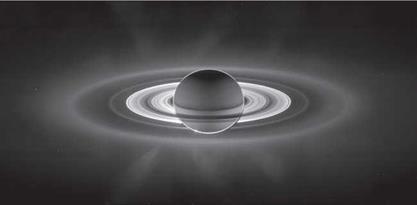BRIGHT RINGS AND ICY WORLDS
“It is a drama as ancient as the sun, as unflinching as time. . . a never – ending whirl of celestial movements, scripted and precise, in a silent show of cosmic force, played out in light and shadow. It is a drama called equinox,” writes Cassini Imaging Team Leader Carolyn Porco in her “Captain’s Log,” an online diary of the Cassini spacecraft’s observations of the ringed world of Saturn and its moons. It takes approximately thirty years for Saturn to orbit the Sun, so the planet only experiences an equinox, when the Sun shines equally on its northern and southern hemispheres, every fifteen years. In August 2009, equinox returned once again for Saturn as Cassini explored Saturn and its moons. “To its operators at significant remove, a billion miles away, it has been a long and gripping wait for this special season about to unfold. . . when the Sun passing overhead from south to north begins to set on the rings,” writes Porco. Observing Saturn in equinox from on site, she reminds us, is “a solemn celestial phenomenon no human has beheld before.”1
All of the large outer planets of our Solar System have rings, though none as magnificent as Saturn’s. The rings, no more than tens of meters thick yet spanning nearly 155,000 miles in diameter, come into sharp and rare relief during equinox when the angle of the Sun’s rays is lowered relative to the ring plane and casts long shadows across the rings (figure 5.1).2 In eloquent and poetic prose Porco comments, “Like the seas of Earth, this wide icy expanse
|
Figure 5.1. Cassini spent twelve hours in Saturn’s shadow in 2006 and took this image looking back toward the eclipsed Sun. Saturn’s night side is partially lit by light reflected from the rings and the rings appear dark where silhouetted against the planet (NASA/JPL/ESA/CICLOPS). |
[ . . . ] froths and churns, not by wind but by the convulsive forces of Saturnian moons. This famous adornment, impressed deep in the human mind for four centuries as a pure, two-dimensional form, has now, as if by trickery, sprung into the third dimension.”3 Equinox on Saturn has since faded to northern summer and we along with Cassini have observed the clear, deep blue skies of Saturn’s northern hemisphere cloud over to reflect Saturn’s signature peach or faded orange hue. Robotic explorers like Cassini have given us entirely new perspectives of other worlds in the outer Solar System.











